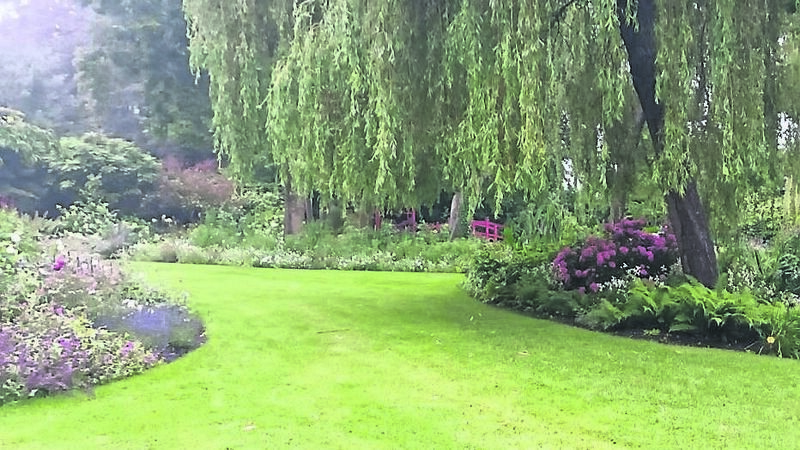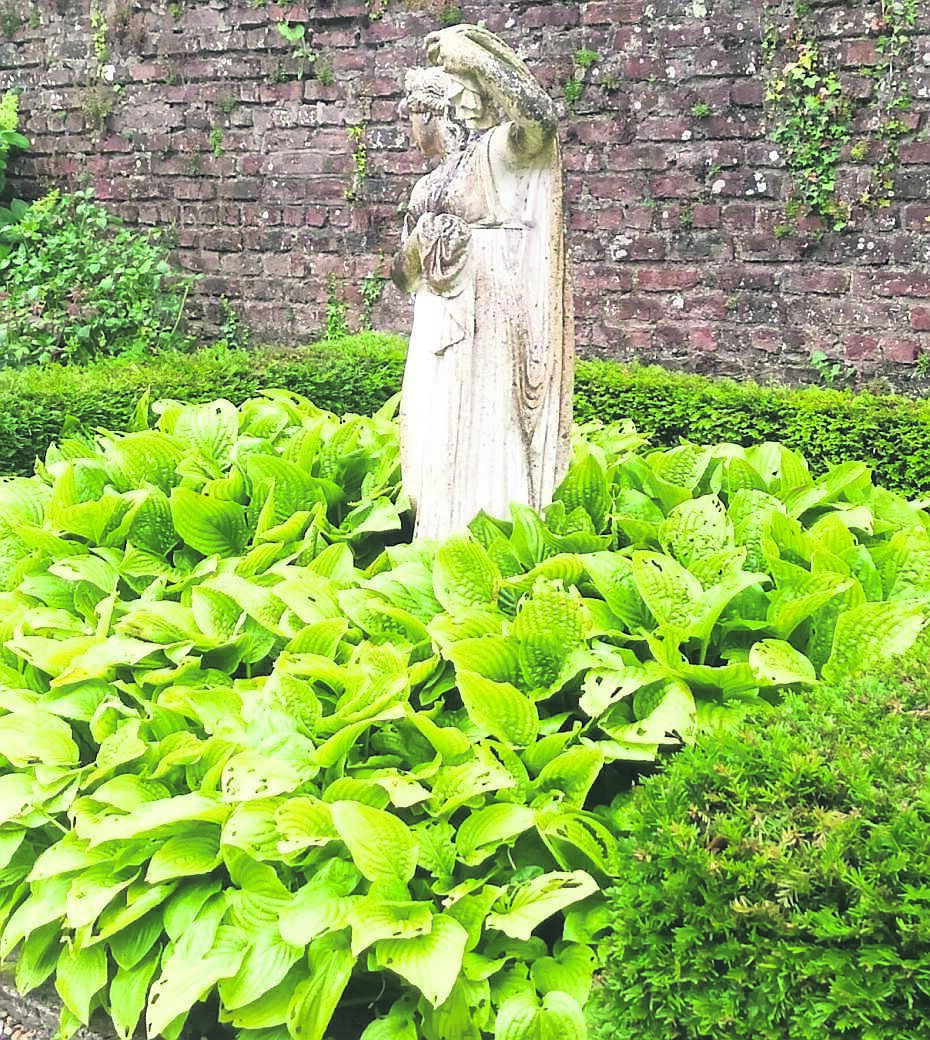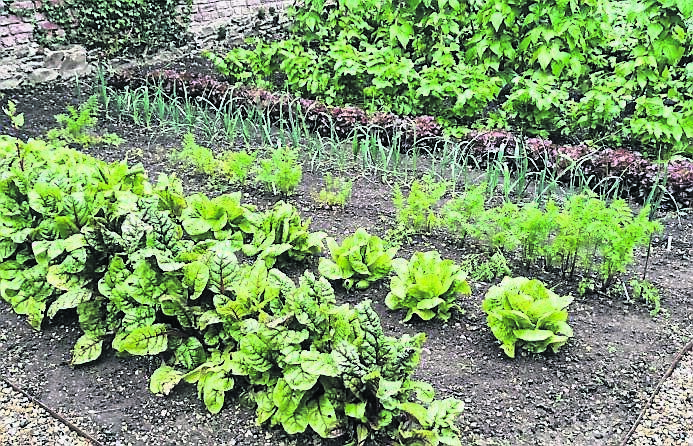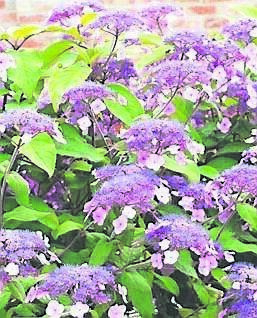A horticultural heaven and a sensory feast to visit

Sweeping curves on the lawns and mature trees give a great backdrop for showcasing planting
AROUND 30 Professional Gardeners Guild (P.G.G.) members arrived together on a wet, dark morning in July to the elegant gateway of a private estate, Kilquade House in Greystones, Co. Wicklow.
The head gardener’s house is to the left, with the main avenue planted with mature trees and green fields. The Georgian mansion stands proud and two sculptures of resting stags sit at the foot of the steps leading to the main door. The view from the house is of rolling fields with a kidney-shaped natural pond. Cleverly designed beds of shrubs are on either side of the house, but what lay behind is a marvel.
The gardens surrounding Kilquade House are a horticultural marvel encompassing over 15 acres of lush greenery and meticulously designed landscapes. Each section offers a unique experience, blending formal and informal styles to create a harmonious whole, from manicured lawns to vibrant flower beds, which are at their best in high summer - even on a wet day!

There are two walled in gardens, the main one is more formal in layout and was created and designed by garden consultant Martin Walsh and head gardener Dave Gillard. It has undergone a proper revamp in the last few years and has raised a bed with substantial herbaceous planting. The bed is about two metres high and can be seen from the other end of the walled garden.
Within the walled garden are several features worth mentioning such as Lonicera nitida, an excellent alternative to box, which is disease-free and responds well to clipping and grows well in all soil types. There is also a pergola with a short repeat flowering rambler rose called ‘Snow Goose’, it bears sprays with small, glistening white pompom flowers with a charming daisy-like appearance. It enhances the pergola with its light musk smell, this will be an impressive sight in years to come. There is also a fruit and vegetable garden, and a helpful tip to keep the birds away is to use bird scare tape.
The second walled garden is large and naturalistic with a stream running through the heart of it.
The tranquil water features and natural running stream meander through cleverly planted beds with Salix babylonica (Weeping Willow) and tree ferns (Dicksonia antarctica) forming part of the planting scheme, giving a very romantic feel throughout.
The Hydrangea in particular in many different colours stole the show for me. They are enjoying this wet period and performing accordingly. As you walk, the eye is drawn and you wonder what lies beyond, and one is not disappointed to find a natural pond.
The woodlands surrounding the house, with stone pathways and large mature trees, serve as a canopy. Head Gardener David says it can be a very dry, shaded area, he uses several plants for dry shade which look well planted in large groups, Brunnera macrophylia ‘Jack Frost’ or ‘Silver Heart’, Hostas, Pachyphragma macrophyllum, Disporum ‘Night Heron’, and the Irish native male fern Dryopteris filix-mas. They grow most of their plants from seeds and use a few Irish and UK suppliers. There are three large polytunnels which house the tropical plants over winter. They leave the Musa basjoo or hardy banana outside, wrapped with chicken wire, and then stuff it with straw to protect from frost. They offer no protection for the tree ferns over the winter months.
Kilquade Gardens is a horticultural heaven that offers a sensory feast for garden lovers and a tranquil escape for the visitor. It is a meticulously designed landscape with diverse plant collections which makes it a destination worthwhile whether you have a passion for gardening or simply appreciate the beauty of nature. It will leave you inspired and rejuvenated even on a wet day!

David and his team of seven gardeners, with design input from consultant Martin, have done a superb job. Group bookings are by appointment only.
Plant of the Week
Hydrangea aspera, commonly known as the rough-leaved hydrangea, is a captivating flowering plant that belongs to the Hydrangeaceae family. Native to parts of east Asia, particularly China, Japan, and Korea, it has garnered popularity among garden enthusiasts and horticulturists worldwide.
The defining characteristic of Hydrangea aspera lies in its unique rough-textured leaves, which set it apart from other hydrangea species. These are elliptical, serrated, and emit an appealing earthy fragrance when gently rubbed between one’s fingers.
Additionally, the plant showcases large, intricate flower clusters that bloom in the late spring and summer months. These blossoms come in a delightful palette of colours, ranging from pale blue and lavender to vibrant pink, adding a touch of elegance to any landscape or garden.
As a deciduous shrub, Hydrangea aspera (inset below) typically thrives in well-drained soil and prefers partial shade to dappled sunlight, making it an ideal choice for gardens with varying light conditions. Its adaptability and low-maintenance requirements make it a favoured choice for both amateur and seasoned gardeners.

Beyond its ornamental value, Hydrangea aspera has also been used in traditional Asian medicine for its potential therapeutic properties. Some studies suggest certain compounds in the plant may possess anti-inflammatory and antioxidant effects.
Overall, Hydrangea aspera stands as a splendid addition to gardens, not only for its aesthetic allure but also for its cultural and medicinal significance, making it a cherished plant.
An elegant compact Hydrangea aspera ‘Anthony Bullivant’ is more suitable than the species for small gardens.







 App?
App?


